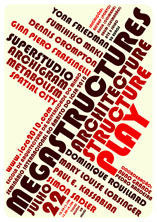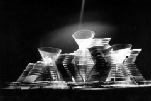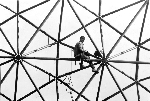|
|
|
| MEGASTRUCTURES - ARCHITECTURE_PLAY_STRUCTURE |
|
 |
22nd July 2010
Program
09h30-10h20 Reception
10.20: Welcome session
10h30: Yona Friedman (video conference)
11h00: Fumihiko Maki
11h30: Dennis Crompton
12h00: Gian Piero Frassinelli
12h30: Debate (moderator: Nuno Grande and Pedro Bandeira)
15h00: Paul E. Kassabian (video conference)
15h30: Mary Louise Lobsinger
16h30: coffee break
17h00: Dominique Rouillard
17h30: Simon Sadler
18h00: Debate (moderator: Pedro Bandeira and Nuno Grande) |
|
The seminar will focus on some megastructural proposals, designed in the 60s and 70s of the twentieth century, in order to discuss the social and cultural context that stimulated, then, a playful and expressive relationship between Architecture and Structure: from quotidian experience to radical utopia. In this sense, the symposium will not only count on the testimony of notorious authors of some of those proposals, but also on the vision of important researchers lately specialized on the matter.
|
|
 |
Dennis Crompton
United Kingdom |
 |
|
Dennis Crompton was a member of the architectural collective Archigram, established in London in 1961. Together with Peter Cook, Ron Heron and Michael Webb, he created a critical “think tank” on experimental architecture and playful urbanism. Combining pop culture and cybernetics, Archigram produced visionary projects such as: Walking City (1964), Plug-in City (1966) and Instant City (1968).
|
 |
Fumihiko Maki
Japan |
 |
|
Fumihiko Maki was a member of the Japanese Metabolist Movement in the early 1960's. His involvement produced numerous theoretical works such as the Shinjuku Station Development, Golgi Structure, Transportation Exchange, and City Room. However, his approach went beyond the famous visionary and technological proposals of Metabolism, embracing architecture's organic and humanist qualities which brought him closer to the Team X cultural debate. Those characteristics can be detected in some of his earlier projects such as Hillside Terrace, Tokyo (1969).
|
 |
Gian Piero Frassinelli
Italy |
 |
|
Born in 1939 in Porto S. Giorgio (Marche) and graduated in architecture at University of Florence in 1968. After having actively participated in the student protests, he was invited in Superstudio from A. Natalini and C. Toraldo di Francia, bringing his knowledge in sociology and anthropology and the techniques of perspective until the closure in 1986.
|
 |
Yona Friedman
France |
 |
|
Yona Friedman (1923) is a Hungarian-born French architect, urban planner and designer, and author of the "Manifeste de l'Architecture Mobile" (1956). His visionary project Ville Spatiale is an example of a megastructure adaptable to the dynamics of social life. In 1958 he founded the Groupe d'études de architecture mobile (GEAM). He has participated actively in the cultural climate and utopian architecture of the 60s known as the "Age of megastructures". In the following decade he worked for the United Nations and UNESCO, through the dissemination of self-building manuals in African countries, South America and India.
|
 |
Dominique Rouillard
France |
|
|
Architect, PhD in Art History, Dominique Rouillard is professor at the Ecole Nationale Supérieure d'Architecture Paris-Malaquais (ENSAPM) and scientific director of the research laboratory LIAT (Laboratoire, Infrastructure, Architecture, Territoire). She is a founding member of Architecture Action, office for architecture and urban design in Paris, and has been scientific consultant for different exhibitions for the Centre G. Pompidou (Les années 50, La Ville, Archigram). Since her work on “Radical Architettura” (Centre G. Pompidou 1993, trad. Monacelli Press 1999), her researches are focused on immediate history of contemporary architecture and infrastructures.
Last publications related to the seminar: Superarchitecture. Le futur de l’architecture 1950-1970 (Ed Villette 2004), La métropole des infrastructures (ed., Picard, 2009), Imaginaires d’infrastructure (ed., L’Harmattan, 2009). The radical non-megastructural projects of Archizoom Group will be the focus of her talk.
|
 |
Mary Louise Lobsinger
Canada |
 |
|
Mary Louise Lobsinger is a historian and theorist of architecture and urbanism. She is Associate Professor of architecture history and theory at the J.H. Daniels Faculty of Architecture, Landscape, and Design at the University of Toronto. She writes on postwar architecture focusing on particular aspects of Italian architectural discourse and new technologies in British and North American architecture. She will examine Cedric Price’s Fun Palace and the politics of learning in the 1960s.
|
 |
Paul E. Kassabian
USA |
 |
|
Paul Kassabian is a structural engineer based in Boston, Massachusetts. Educated at Cambridge University, Paul worked in the UK on various distinctive bridge structures, including the Gateshead Millennium Bridge, with WilkinsonEyre Architects. In the US, Paul works at the structural and envelope engineering firm of Simpson Gumpertz & Heger (SGH) where he focuses on designing innovative structures. He also teaches a graduate level course each semester at MIT. His talk will be on the structural design and construction of Biosphère for Expo ’67 and Spaceship Earth in Disneyworld, for which SGH was the structural engineer.
|
 |
Simon Sadler
USA |
 |
|
Simon Sadler is a British architectural historian based in the USA at the University of California, Davis. His books The Situationist City (MIT Press, 1998), Archigram: Architecture without Architecture (MIT Press, 2005), and more recent papers on countercultural architecture in the USA, reappraise the most radical urban and architectural visionaries of the 1950s-1970s. Constant’s “New Babylon” project will be his keynote topic at this seminar.
|
 |
Nuno Grande
Portugal |
 |
Pedro Bandeira
Portugal |
|
|
|